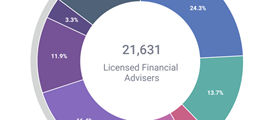Find an adviser or ask an adviser for free on our Q&A form
Learn finance and industry insights through our curated articles, videos and adviser Q&A's
More Adviser Ratings
Adviser Weekly Newsletter 1 Oct 2025

1 October 2025
Beyond Niching: Strategic Intentionality Beats Specialisation Every Time
Adviser Weekly Newsletter 24 Sep 2025

24 September 2025
From Compliance to Cool: How Smart Advisers Beat Finfluencers at Their Own Game
Adviser Weekly Newsletter 3 Sep 2025

3 September 2025
The Great Adviser Race: Can Australia Build Its Financial Army Before Demographics Strike
Adviser Weekly Newsletter 27 Aug 2025

27 August 2025
From Reactive to Rich: The Strategic Playbook for Advice Practice Success
Adviser Weekly Newsletter 21 Aug 2025

21 August 2025
Beyond the Rankings: Why Advisers Choose Products That Don't Always Lead the Ratings
Adviser Weekly Newsletter 6 August 2025

6 August 2025
The CSLR Levy: Can a Stabilising Profession Afford Another Hit?
Adviser Weekly Newsletter 31 July 2025

31 July 2025
Six Years Later: Life Insurance Finally Finds Its Post-Crisis Footing
Adviser Weekly Newsletter 23 July 2025

23 July 2025
From Crisis to Cash Cow: How Smart Insurers Are Turning Industry Chaos Into Competitive Gold
Adviser Weekly Newsletter 16 July 2025

16 July 2025
The Retirement Battleground: Where 97% of Advisers Say Experience Beats Everything Else
Adviser Weekly Newsletter 2 July 2025

2 July 2025
Why a $15M Client Fired Their Adviser—The Cost of One Google Search (and a Couple of TikTok Videos)!
Adviser Weekly Newsletter 25 June 2025

25 June 2025
The Great Rebalancing: Why Advisers No Longer Care About Your Investment Menu
Adviser Weekly Newsletter 18 June 2025

18 June 2025
Beyond the Coffee Catch-Up: How BDMs Are Becoming Strategic Powerhouses
Adviser Weekly Newsletter 11 June 2025

11 June 2025
The $16 Billion Vote of No Confidence: How Platform Super is Crushing Industry Funds
Adviser Weekly Newsletter 4 June 2025

4 June 2025
Done Beats Perfect: Why Your Half-Finished Business Plan Is Costing You $100,000s
Adviser Weekly Newsletter 29 May 2025

29 May 2025
A Hard Day's Plight: Financial Advisers Face Outsourcing Dilemma
Adviser Weekly Newsletter 14 May 2025

14 May 2025
The AI Revolution in Financial Advice: Australian Practices Leading Global Adoption
Adviser Weekly Newsletter 7 May 2025

7 May 2025
From Advisers to Business Architects: The New Blueprint for Advice Success
Adviser Weekly Newsletter 30 April 2025

30 April 2025
The Adviser's Election Playbook: Voting for Your Practice's Future
Adviser Weekly Newsletter 9 April 2025

9 April 2025
"When, Not If": How Top Financial Advisers Are Preparing for Cyber Attacks. Australian financial advisers are slashing IT budgets by 12% while boosting cybersecurity investments by 31% following devastating attacks on major super funds. With average breaches costing financial firms $7.56 million, practices are prioritising security over new systems as regulators demand "cyber vigilance."
Adviser Weekly Newsletter 2 April 2025

2 April 2025
No Reform, No Problem: Why the Profession Couldn't Wait for Political Solutions
Adviser Weekly Newsletter 26 March 2025

26 March 2025
CARs to the Left of Me, Budgets to the Right — Here I Am, Stuck in the Middle of an Election with You
Adviser Weekly Newsletter 19 March 2025

19 March 2025
The $4 Trillion Super Secret: Why Advisers Choose Differently New data reveals a stark disconnect: while AustralianSuper and other industry giants lead APRA's rankings, adviser fund flows tell a different story.
Adviser Weekly Newsletter 12 March 2025

12 March 2025
The Unsung Guardians: How Financial Advisers Protect Communities from Fraud New research shows that financial advisers protect entire communities from fraud. As the number of advisers declined following regulatory reforms, areas with higher adviser attrition saw 8.8% more fraud incidents.
Adviser Weekly Newsletter 5 March 2025

5 March 2025
The End of Apples vs. Oranges: How SMARS Is Standardizing SMA Reporting The new SMA Reporting Standard (SMARS) addresses inconsistencies in the rapidly expanding $200 billion SMA market.
Adviser Weekly Newsletter 26 Feb

26 Feb 2025
90% of Australians Need Advice — Technology Is How You'll Reach Them Fewer than one in ten Australians receive professional financial advice—an untapped market ripe for innovation.
Adviser Weekly Newsletter 19 Feb

19 Feb 2025
Digital Dreams vs Consumer Reality: Bridging the Financial Advice Divide Despite significant industry investment in digital advice solutions, fewer than one-third of Australians have adopted digital financial tools. While younger demographics show increasing interest, acceptance drops sharply with age.
Adviser Weekly Newsletter 12 February 2025

12 February 2025
Every Step Counts: Your FAR Destination Must Be Reached in 11 Months
Adviser Weekly Newsletter 5 February 2025

5 February 2025
Q4 2024 Musical Chairs Report: Fresh Off the Press!
Adviser Weekly Newsletter 30 January 2025

30 January 2025
The True Cost of Advice: Why Your Financial Adviser Isn't Getting Rich
Adviser Weekly Newsletter 22 January 2025

22 January 2025
Fee Evolution: New Opportunities in the Wake of DBFO Reforms
Adviser Weekly Newsletter 15 January 2025

15 January 2025
The Seven Deadly Sins of Financial Advice Practices: What Top Firms Avoid
Adviser Weekly Newsletter 08 January 2025

08 January 2025
From Compliance to Innovation: How Advisers Can Lead the Charge in 2025
Adviser Weekly Newsletter 18 December 2024

18 December 2024
Building Tomorrow’s Profession: Insights from 2024 and Strategies for 2025
Adviser Newsletter 11 December 2024

11 December 2024
2024: A Transformative Year for Australian Financial Advice
Adviser Newsletter 4 December 2024

4 December 2024
The End of SOAs: A Blank Canvas for Reimagining Advice
Adviser Weekly Newsletter 20 November 2024

20 November 2024
Designing for Efficiency: How Leading Practices Are Reimagining Their Operations
Adviser Weekly Newsletter 6 November 2024

6 November 2024
Data Analytics Excellence: Unleashing Growth and Efficiency in Top Advice Practices
Adviser Weekly Newsletter 30 October 2024

Adviser Weekly Newsletter 03 October 2024
The New DNA of Advice Leadership: How Top Firms Are Building 40% Margins
Adviser Weekly Newsletter 23 October 2024

23 October 2024
Scaling Up: How Innovative Advice Models Are Making Professional Advice More Accessible
Adviser Weekly Newsletter 16 October 2024

16 October 2024
The Evolution of Client-Centric Financial Advice: Embracing Digital Solutions for Enhanced Engagement
Adviser Weekly Newsletter 9 October 2024

9 October 2024
Haven't We Been Down This Road Already? Excellence in Regulatory Change
Adviser Weekly Newsletter 2 October 2024

2 October 2024
The Rise of Super Firms: Defining Excellence in Australian Financial Planning
Adviser Weekly Newsletter 25 September 2024

25 September 2024
Ask An Adviser - What Insurances Are Essential To Protect My Young Family?
Adviser Weekly Newsletter 18 September 2024

18 September 2024
Advisers Are Being Forced To Eat a Bag of Dixon
Adviser Weekly Newsletter 11 September 2024

11 September 2024
Advisers Positioned for Opportunity to Address Gaps in Life Insurance Market
Adviser Weekly Newsletter 4 September 2024

4 September 2024
Advisers Guiding the Great Wealth Transfer: Key Trends and Client Concerns in 2024
Adviser Weekly Newsletter 28 August 2024

28 August 2024
One-Off Client Fees: An Opportunity for Market Entry and Adviser Revenue Growth
Adviser Weekly Newsletter 21 August 2024

21 August 2024
Revenue and Client Acquisition: Financial Advisers' Growth Decisions
Adviser Weekly Newsletter 14 August 2024

14 August 2024
Musical Chairs Q2 2024: Platforms in the Spotlight
Adviser Weekly Newsletter 7 August 2024

7 August 2024
Emerging Trends in Australian Investment Options: Navigating the Shifts
Adviser Weekly Newsletter 24 July 2024

24 July 2024
Stabilising the Sector: The Resilient Financial Advisers of 2024
Adviser Weekly Newsletter 17 July 2024

17 July 2024
The Optimal Financial Advice Practice in 2024: Blueprint for Success. What sets the most successful advice practices apart? Our nationwide survey reveals how top practices are achieving high profit margins, the type of clients they are targeting, and how they leverage technology and embrace female leadership. Find out what the best practices in 2024 look like and how your firm can thrive.
Adviser Weekly Newsletter 10 July

10 July 2024
Advice Fees Rise: What Australians Are Really Willing to Pay for Financial Advice Financial advisers have had to raise fees by 58% over the past five years. With many Australians feeling the financial squeeze, what are consumers actually willing to pay for advice?
Adviser Weekly Newsletter 3 July

3 July 2024
The Face of Financial Advice: What the Average Australian Adviser Looks Like in 2024 With increasing workloads and changing financial landscapes, how are advisers adapting? How much are advisers earning now? What fees are they charging?
Adviser Weekly Newsletter 19 June

19 June 2024
Profit Boost: The Transformation of Australian Advice Practices Through Tech In the evolving landscape of financial advice, technology is key to boosting profitability. Australian practices tell us where they are streamlining operations with tech while cutting staff costs and significantly enhancing efficiency. How are you leveraging technology to transform your practice and enhance your competitive edge?
Adviser Weekly Newsletter 12 June

12 June 2024
How does your tech stack measure up to industry standards?Reshaping the dynamics for financial advisers, integrated software solutions and research tools are a game-changer for efficiency and client engagement. Comprehensive tech stacks, featuring CRM, advice production, revenue management, and more, are driving exponential growth and innovation. Our latest survey of Australian advisers reveals where growth is happening.
Adviser Weekly Newsletter 5 June 2024

5 June 2024
The Rise of Digital Financial Solutions in Australia: A Paradigm Shift in Money Management. As digital solutions reshape personal finance, Australians are embracing a new era of financial management. From automated investing to real-time budget tracking, discover how technology is simplifying complex financial processes and what this means for consumers and providers alike.
Adviser Weekly Newsletter 29 May 2024

29 May 2024
As financial landscapes grow more complex, the value of financial literacy soars. Our recent survey underscores the dramatic impact of knowledgeable guidance on investment success. Find out how informed consumers are changing the face of financial advice.
Adviser Weekly Newsletter 15 May 2024

15 May 2024
As Australia anticipates the transfer of $3.5 trillion in assets by 2050, the need for effective wealth transfer planning is becoming increasingly apparent. Surprisingly, our latest survey reveals that a staggering 80% of consumers are without a solid plan, highlighting a significant gap in financial readiness. Our analysis explores how advisers are stepping up and broadening their strategies beyond traditional estate planning to better serve their clients and secure a financial legacy for future generations.
Adviser Weekly Newsletter 8 May 2024

8 May 2024
Despite a clear uptick in those seeking financial advice amid mounting economic pressures, high advisory fees remain a significant hurdle for many. With our recent survey of Australian consumers revealing 79% remain unadvised, the industry continues to face the pivotal question—how will it adapt to serve a broader market? Dive deeper into our consumer survey insights.
Adviser Weekly Newsletter 1 May 2024

1 May 2024
Released just moments ago, the first quarter of 2024 Musical Chairs Report is your essential update on pivotal industry transformations. With 85% of advice practices now privately owned, delve into our new section that explores the evolving nature of practices and their strategic adaptations for increased profitability. Don’t miss this quarter’s special feature as our industry prepares to relaunch with QAR recommendations and a future-focused outlook. Plus, reflecting on a decade of change, we ask: has advice reached an inflection point? Download the full report now to explore the insights helping to define the next phase of financial advising.
Adviser Weekly Newsletter 24 April 2024

24 April 2024
As artificial intelligence further weaves into the fabric of financial services, we explore its emerging role and client attitudes. We’ve surveyed Australian advisers and consumers to gauge its impact on the industry. From cost reductions to enhancements in client management, the responses we received are diverse—but the trend is clear. AI is undoubtedly here to stay, but how are practices adjusting to this new normal?
Adviser Weekly Newsletter 17 April 2024

17 April 2024
Our latest survey dissects the strategic nuances between generalist and specialist financial advisers, exploring their impact on client demographics, funds under management, and fee structures. Amidst an evolving industry landscape, these distinctions are critical for adapting business strategies to meet client demands and drive growth. The emerging patterns reveal stark contrasts that could fundamentally alter your financial advising approach.
Adviser Weekly Newsletter 10 April 2024

10 April 2024
As she approaches her early 50s, Sophia is keen to devise a comprehensive strategy that maximises her retirement income, ensuring comfort in her later years. Delve into expert insights from Robert Daniele of Robert's Retirement Advisory and Chris Brown of Chapters Retirement Partners, as they share their perspectives on the most effective approaches to achieve financial stability for a secure future.
Adviser Weekly Newsletter 28 March 2024

28 March 2024
Amidst an unprecedented year of participation, we're thrilled to unveil the prize-winning advisers from our annual nationwide survey and share their positive feedback. We'd like to thank all the advisers and practice heads who contributed their insights and helped to shape our most comprehensive landscape study yet. With your voice amplified, we're driving positive change, holding suppliers accountable, and influencing policies for the betterment of our industry.
Adviser Weekly Newsletter 20 March 2024

20 March 2024
Discover how PI insurance is more than just a formality for advisers. Beyond a mere requirement for your Australian Financial Services Licence, uncover the unforeseen complexities and challenges that lurk beneath the surface. Learn about the pivotal moments where it can all go wrong and the essential strategies to navigate through the unpredictable terrain of claims, operational pitfalls, and market upheavals. Dive deeper into safeguarding your practice—before it's too late.
Adviser Weekly Newsletter 13 March 2024

13 March 2024
This week's 'Ask an Adviser' explores transformative strategies for setting ambitious yet achievable financial goals and monitoring progress with precision. Three financial advisers, Olivia Glare of Consortium Private Wealth, Mark Candy of Vogue Advisory Group, and Stephen Gulbrandson of Morgans Financial, provide Emma with their expertise to capitalise on her recent career advancement and support her long-term financial aspirations, along with innovative tools and methods.
Adviser Weekly Newsletter 7 March 2024

7 March 2024
After four long years of hard work and collaboration, we've broken new ground in Professional Indemnity insurance with Numerisk. In an industry shaken by a sharp decline in adviser numbers - largely due to sky-high insurance costs and scarce availability - we're lighting the path forward. With Adviser Ratings' innovative approach to assessing adviser quality and Numerisk's deep insurance expertise, we're setting a new standard. This partnership isn't just a solution; it's a revolution. Ready to see how we're changing the game?
Adviser Weekly Newsletter 28 February 2024

28 February 2024
The clock is ticking! With the survey closing tomorrow, join over 1,200 advisers who are already paving the way in uncovering crucial industry trends. From significant adviser salary growth and evolving client demographics to the strategic adoption of managed accounts, these insights are shaping your future. Don’t miss this unique opportunity to access deeper insider insights, and benchmark against local and national trends for your strategic growth. With $40k in prizes, this is more than a survey - it’s your gateway to industry leadership and advisory excellence.
Adviser Weekly Newsletter 21 February 2024

21 February 2024
In 2006, two dichotomous events took place- managed accounts were first launched and started to gain traction with a handful of advisers, and Taylor Swift launched her inaugural album (we couldn’t help ourselves!). One obviously gained more traction at the outset than the other. Whilst there has been multiple explosions of “Swifties” with every new album release, headline or concert, it took a further 15 years for Managed Accounts to gain much traction. But not without controversy?
Adviser Weekly Newsletter 14 February 2024

14 February 2024
As Treasury propels advice reforms forward, a new breed of 'qualified advisers' is set to emerge. Banks, insurers, super funds—oh my. Set to advise on simple or limited scope items, what will these changes mean for the profession in 2024? Dive into the latest industry shifts, and with our spotlight on LIF reforms turning heads in the industry, you won't want to miss what's inside our in-depth report—your gateway to staying ahead of the evolving landscape of financial advice.
Adviser Weekly Newsletter 7 February 2024

7 February 2024
Years on from the seismic shifts of the Life Insurance Framework (LIF) reforms, the ripples are not only still visible—they're reshaping the landscape. Our exclusive analysis draws a vivid line from the reforms' capped remuneration and the new business terrain, showcased in the newest edition of our Musical Chairs report. Download your copy for unparalleled industry insights and witness firsthand how these pivotal changes are redrawing the risk advice landscape, compelling strategies to evolve, and setting new precedents for the future of life insurance.
Adviser Weekly Newsletter 31 January 2024

31 January 2024
Charging into 2024 with momentum, early findings from our ongoing Landscape Study unveil a thrilling era of growth. As adviser salaries boom, part of this narrative is owed to the dramatic transformation in Professional Indemnity insurance. Intrigued by what’s fueling these salary surges and the shifts in PI insurance? Our article sheds light on these dynamics, offering insights to navigate this promising dynamic phase.
Adviser Weekly Newsletter 24 January 2024

24 January 2024
Insights from our latest Advice Landscape study have landed, revealing a significant rise in adviser satisfaction with life insurers - a result of profound industry reforms. We delve into the notable reversal in NPS trends and the dynamic forces reshaping life insurance, from cutting-edge technology to emerging regulatory challenges.
Adviser Weekly Newsletter 17 January 2024

17 January 2024
Ready for your professional presence to take the lead online this year? Embark on a new era of growth where attracting your ideal clients is as simple as enriching your free profile. More than just visibility, our platform is a tool for expansion, generating thousands of leads for Australian advisers annually. Discover how to effortlessly enhance your SEO, explore our partner 'find an adviser' sites like Colonial First State and AustralianSuper, and hear from the advisers benefiting from their profiles.
Adviser Weekly Newsletter 13 December 2023

13 December 2023
It's that time of year where we ask you, the adviser community, for your feedback and give you the opportunity to benchmark yourself against the Australian adviser universe. Participation brings dual rewards: Instant entry into a $40k prize draw and and access to a bespoke regional analysis report. This respected tool is used yearly by advisers to evaluate their standing against local rivals. In 2024, as the industry and government work to meet advice demand, insights for holistic and risk advisers are key, making your input more crucial than ever.
Adviser Weekly Newsletter 6 December 2023

6 December 2023
In the face of a cost-of-living crunch, Australians pivot towards securing immediate financial stability and safeguarding long-term wealth. This shift sidelines ESG priorities, highlighting a pragmatic focus on security over sustainability.
Adviser Weekly Newsletter 29 November 2023

29 November 2023
Amidst the sales pressures and the surge of artificial intelligence, there are a handful of complexities that appear to be driving a whopping 79% of paraplanners away from embracing advisory roles. With regulatory changes afoot, will the industry see a radical shift or maintain its status quo?
Adviser Weekly Newsletter 22 November 2023

22 November 2023
The battle for platform FUA is heating up. With switching decisions poised to peak in the coming years, advisers find themselves in a prime position to capitalise on this shifting landscape. To better understand the factors influencing advisers' platform choices, we explored some of the key drivers that shape the decision-making process.
Adviser Weekly Newsletter 16 November 2023

16 November 2023
Is the government's financial legislation overhaul a game-changer or a missed opportunity? As anticipation mounts, the initial wave of financial reforms aims to reduce red tape for advisers. However, industry responses remain divided. We delve into advisers' perspectives on the first tranche of QAR legislation, as well as the recommendations garnering positive attention.
Adviser Weekly Newsletter 8 November 2023

8 November 2023
Hot off the press! Quarter three's Musical Chairs report unveils a reassuring outlook for the advice profession, showcasing a workforce on the mend. And be sure to catch our exclusive feature, diving into how advisers are leveraging digital tools for success. A special thanks to our report sponsor, BT Financial. Ready for insights? Download your copy now.
Adviser Weekly Newsletter 1 November 2023

1 November 2023
In an economic terrain marked by soaring living expenses and stagnant wage growth, the imperative to shield savings against purchasing power erosion is taking centre stage. In this week's instalment of our Ask an Adviser series, financial advisers Eden Smith of Bensons Wealth and Ryan Scherini of Viridian Financial Group explore strategies for safeguarding savings from inflation, prompted by a question from Amara in Bondi, NSW.
Adviser Weekly Newsletter 25 October 2023

25 October 2023
Explore the journeys of Australian sports legends who’ve become financial advisers. With Ange-Ball taking hold in the premier league, the Matildas putting a shine to our lives and the Wallabies despairingly leaving French shores as we bemoan a NZ-SA Rugby World Cup final, our Australian sports-psyche is enmeshed in us. These icons emphasise the parallel skills between sports and advice plus how they leverage their sporting mindset to make a tangible difference in their clients’ lives.
Adviser Weekly Newsletter 18 October 2023

18 October 2023
While the broader Australian economy thrived during the pandemic, 30% of advice practices closed their doors. Navigating the path to recovery and attending to both existing and new clients presents a formidable challenge, with a long road ahead. In this article, we delve into the industry’s reinvigorated sense of purpose and direction, featuring special commentary from financial advisers.
Adviser Weekly Newsletter 11 October 2023

11 October 2023
As ESG activity continues to boom, consumers grapple with important decisions in the wake of Australia's $4 billion commitment to clean energy. This week's response explores the dynamic landscape of ESG and sustainable sector investments, providing key details for investors like Luis.
Adviser Weekly Newsletter 4 October 2023

4 October 2023
In the fast-paced world of financial advice, the often-overlooked cornerstone of success is the business plan. Although solo practitioners may contend that their agility renders a formal plan unnecessary, the numbers tell a different story. Our findings underscore a critical point: it's not just a formality—it's a tool for growth and resilience in the ever-evolving advice landscape.
Adviser Weekly Newsletter 27 September 2023

27 September 2023
Amidst Australia’s evolving financial scene, small licensees are surging, marking a 17% increase since 2018 in the AFSL sector. This rise is reshaping advisory services, leading to diversified, specialised offerings and posing essential inquiries into implications for advisers’ choices and the transformation of the financial advisory framework.
Adviser Weekly Newsletter 20 September 2023

20 September 2023
Australia's super funds hold the keys to our retirement security, but many are complacent. Disturbing trends suggest that funds are not doing enough to support their members in retirement. With the superannuation system now at a crossroads, whatever the outcome, the implications will be felt by every Australian retiree.
Adviser Weekly Newsletter 13 September 2023

13 September 2023
As Integrity Life crumbles, a telling imbalance emerges: just 493 advisers hold half the deck of this year’s life policies. With underinsurance costing Aussie families a potential $25 billion, the industry races against time, seeking innovation from within its own ranks and hoping its own community can pioneer the necessary transformation.
Adviser Weekly Newsletter 6 September 2023

6 September 2023
While there's chatter about how regions are ranked, we give you a behind-the-scenes look into our top 25. Amidst a changing tableau where advisers navigate diverse regions, as demographics transform and new opportunities surface, our rankings provide a hint for businesses charting their course. As digital dominance rises and geographic importance fades, a robust online presence takes centre stage. How do you view our top 25 regional revelations?
Adviser Weekly Newsletter 30 August 2023

30 August 2023
This week's consumer question looks at how to effectively prepare for retirement with a low super balance. A big thank you to Sarah Roelofs of Acquira Wealth Partners for responding to Christa's question.
Adviser Weekly Newsletter 23 August 2023

23 August 2023
Taking into account factors such as growth, adviser presence, income, and affluence, we investigated the leading 10 regions for advisers in Australia. Discover the key areas where financial experts can seize opportunities, including an exclusive glimpse into the top-ranked region.
Adviser Weekly Newsletter 16 August 2023

16 August 2023
Australian advisers are increasingly leaning into passive, listed investment models, with over $1 billion now modelled through the top-rated ProductRex platform. Yet, the active ETF sector lags. Are misconceptions about market trends to blame? We explore the myths surrounding "listed" versus "passive" effects and uncover the true drivers in today's market.
Adviser Weekly Newsletter 9 August 2023

9 August 2023
Fresh off the press! Quarter two's Musical Chairs report spotlights the uplifting transformation in the financial advice realm. With fewer advisers opting to exit, the industry is changing tides from previous patterns. Featured in this release are "The Platforms poised to win future flows." Australian advisers' top-rated platforms are now dominating market flows as we delve into our Platform Quarterly Driver Analysis Benchmarking. Ready for insights? Download your copy now. A special thanks to our report sponsor, BT Financial.
Adviser Weekly Newsletter 2 August 2023

2 August 2023
With Insignia jumping into the co-equity model, could AMP follow suit? With AMP's access to their investment platforms, such as AMP North, it's conceivable that they might cherry-pick superior advice practices, especially those they are familiar with. This approach could provide an added layer of visibility and comfort, understanding the inner workings of their licensed practices.
Adviser Weekly Newsletter 26 July 2023

26 July 2023
Super funds are poised to help many more Australians with their retirement needs, with the Quality of Advice Review response singling them out to improve advice accessibility. More recently though, a report shows there’s much room for improvement when it comes to how funds assess and respond to members’ income needs. It prompts questions about how prepared funds are for their next starring role.
Adviser Weekly Newsletter 19 July 2023

19 July 2023
While adviser numbers are generally improving, we witnessed the usual bump in exits at the end of the last financial year. Adviser Ratings has taken a look at the past year’s trajectory – and what it may mean for numbers in the future.
Adviser Weekly Newsletter 12 July 2023

12 July 2023
As markets continue to throw up challenges, advisers are making the most of the expanded catalogue of investment options available to them. In five charts, we’ve looked at how preferences have changed between last year and now.
Adviser Weekly Newsletter 5 July 2023

5 July 2023
Generative artificial intelligence has exploded onto the scene, with businesses increasingly embracing it to improve productivity and reduce costs. But should advisers see AI as a threat or a supplement? We’ve taken a look at what AI may mean for practices and a few of the ways it may be able to help.
Adviser Weekly Newsletter 28 June 2023

28 June 2023
In what was always expected to be a big year of change, Adviser Ratings made a series of predictions at the start of the 2023 calendar year about the profession’s evolution. We’ve revisited those predictions to see how they’ve panned out.
Adviser Weekly Newsletter 21 June 2023

21 June 2023
Advisers frequently help their clients plan for the future, but what about planning for their own businesses? Adviser Ratings research has consistently found succession planning to be an area of vulnerability for many practices, and it has been complicated by talent supply shortages. Here, we reveal the most recent data when it comes to succession and the intention to continue in advice.
Adviser Weekly Newsletter 14 June 2023

14 June 2023
The Assistant Treasurer has handed down his long-awaited response to the Quality of Advice Review, adopting the majority of the recommendations. Here’s how your industry colleagues are expected to respond and what we can expect next.
Adviser Weekly Newsletter 7 June 2023

7 June 2023
With most remaining advisers now planning to stay in the profession, we’ve seen a shift in how businesses are positioning themselves. Large investments have been made in the past few years and growth has become the next big priority. Here’s what else your industry colleagues will be focusing on over the next 12 months.
Adviser Weekly Newsletter 31 May 2023

31 May 2023
Risk adviser numbers have been in freefall for years, and the segment contracted by more than half in 2022. Research we’ve recently conducted looks at the current state of affairs and what the future may hold for the risk/life space.
Adviser Weekly Newsletter 24 May 2023

24 May 2023
While most Australians say they can’t afford to pay for financial advice, an increasing number would spend up to $5000 a year. Who are these prospective clients? We’ve used our survey data to look at their attitudes towards current financial challenges, which may shed light on what’s changed.
Adviser Weekly Newsletter 17 May 2023

17 May 2023
As advisers have awaited the Government’s next moves on the Quality of Advice Review, there have been several calls for action on ‘quick win’ recommendations, which could be implemented easily to improve advice access. We asked advisers for their thoughts.
Adviser Weekly Newsletter 10 May 2023

10 May 2023
As technology becomes more integral to how advisers manage their businesses, we analysed how today’s solutions are measuring up. Several newer players have received top scores from advisers, while incumbents are still trailing on the satisfaction front. However, when it comes to market share, the popular new providers still don’t have the same reach.
Adviser Weekly Newsletter 3 May 2023

3 May 2023
In a few short years, the advice profession has undergone a metamorphosis. The typical adviser has changed quite a bit, too. On average, advisers are now seeing more clients AND charging much more than they were a few years ago, and relying on different tools to manage their businesses. As we launch our 2023 Adviser Landscape report, we’ve put together some key insights into how the profession has evolved.
Adviser Weekly Newsletter 26 April 2023

26 April 2023
Every business puts a slightly different stamp on its financial advice. But what do the top-earning businesses have in common? We’ve used research from our soon-to-be-released Landscape Report to shine a light on what high-revenue practices do differently. The results may surprise.
Adviser Weekly Newsletter 19 April 2023

19 April 2023
The appetite for environmental, social and governance investing shows no sign of abating, with advisers planning to channel more client money into responsible funds. However, the issue of ‘greenwashing’ – where brands make misleading statements about their sustainability efforts – has made ESG investing more complicated. As the topic starts to make headlines, advisers may start to field more questions from clients. Preparation is key.
Adviser Weekly Newsletter 12 April 2023

12 April 2023
Many advisers raised their fees last year and have signalled further increases are on the cards as their costs spiral. But for three-quarters of prospective clients, even the lowest fees on the market are out of reach, research from our soon-to-be released Adviser Landscape Report shows. We break down where demand is coming from, what consumers want and how confident advised clients are feeling.
Adviser Weekly Newsletter 5 April 2023

5 April 2023
Financial adviser numbers are already at critical levels after thousands of departures in the past five years. However, analysis we’ve conducted for our soon-to-be-released Landscape Report indicates the profession could lose thousands more. For those who are undecided about staying, the uncertainty is partly driven by the wait for clarity on how experience will be recognised.
Adviser Weekly Newsletter 29 March 2023

29 March 2023
The limited licensee model became popular with accountants five years ago, but a series of changes have caused most of these professionals to hand back their licences. We take a close look at the numbers, what’s happened, and what the Quality of Advice Review says about the future for limited licensee accountants in advice.
Adviser Weekly Newsletter 22 March 2023

22 March 2023
With Australia’s two major advice associations set to merge, we took a look at the historical and current membership numbers for the Association of Financial Advisers (AFA) and Financial Planning Association (FPA). The figures shed light on how much value advisers see in advocacy as the profession continues to evolve.
Adviser Weekly Newsletter 15 March 2023

15 March 2023
As Australians increasingly struggle with the cost of living, demand for pro bono advice is on the rise. We spoke with the chair of the Pro Bono Financial Advice Network (PFAN), Nicola Beswick, about how advisers can get more involved.
Adviser Weekly Newsletter 8 March 2023

8 March 2023
Few would argue technology doesn’t have a much bigger role to play in financial advice, but several factors will dictate how that will manifest. In light of that, we’ve taken a look at how advisers have been integrating technology to date – and where they demand improvements.
Adviser Weekly Newsletter 1 March 2023

1 March 2023
A recent report suggests the wealth-management industry could do more to target and retain female clients. Should practices be adapting their offering to better attract this enormous cohort? And does the industry need to do more to attract women to the profession?
Adviser Weekly Newsletter 22 February 2023

22 February 2023
As Treasury prepares to consult on the Quality of Advice Review recommendations, we asked advisers whether they were in favour of the proposals for reform. While many support the new roadmap, others have expressed skepticism about whether we’ll see meaningful change.
Adviser Weekly Newsletter 15 February 2023

15 February 2023
While there’s always a time lag with legislative change, several of Michelle Levy’s Quality of Advice recommendations could be implemented quickly. We take a look at which ones would be easier to enact – and what they could mean for advisers and consumers.
Adviser Weekly Newsletter 8 February 2023

8 February 2023
For Randall Stout, advice is about helping clients feel empowered in the decisions they make. Here, he shares how he became an adviser, how he approaches client relationships and what has kept him up at night in the past couple of years.
Adviser Weekly Newsletter 1 February 2023

1 February 2023
After losing more than 12,000 advisers in four years, the industry still has a bit more pain to come. In fact, as we await further word on measures to improve the accessibility and affordability of advice, our latest data indicates almost a quarter of advisers have told us they may still leave.
Adviser Weekly Newsletter 25 January 2023

25 January 2023
As practices hit the accelerator on another year, we’ve done research on what they think the major trends will be in financial advice. From investment to regulation, 2023 is shaping up to be another gamechanger for the profession.
Adviser Weekly Newsletter 18 January 2023

18 January 2023
When COVID-19 and the first lockdowns hit, advisers were swamped with one-off requests for help. Two years later, businesses are still seeing a higher proportion of one-off clients than they did pre-pandemic. We look at some of the reasons for the shift.
Adviser Weekly Newsletter 11 January 2023

11 January 2023
As we begin a new year, Adviser Ratings speaks to Financial Planning Association CEO Sarah Abood about how she would like to see the profession evolve, the status of the merger with the Association of Financial Advisers, and what the industry needs to do to attract new talent to a planning career.
Adviser Weekly Newsletter 21 December 2022

21 December 2022
It’s been another huge year for financial advisers, with the advice universe again looking leaner at the end of 2022. We take a look at how numbers have changed this year, how the licensee landscape has evolved and which power players have lost the most advisers.
Adviser Weekly Newsletter 14 December 2022

14 December 2022
Years after the industry took its first steps towards professionalisation, a study has looked at the social and ethical attributes of today’s advisers. Comparing them with data from 2009, it asked the question: Are today’s advisers more professional than those of the past?
Adviser Weekly Newsletter 7 December 2022

7 December 2022
As practices grapple with inflation and a slimmed down workforce, a whopping 93 per cent of advisers say they plan to increase their fees next year, a new Adviser Ratings poll shows. For advisers themselves, changing economic conditions and rising costs necessitate the increases, but for some clients, it will push advice further out of reach.
Adviser Weekly Newsletter 30 November 2022

30 November 2022
The risk advice sector has contracted rapidly in the past six months, with the bulk of advisers now writing little to no business in the category. It’s left a small proportion of the industry managing most of the inforce. The change to the landscape comes as the Quality of Advice Review considers how to proceed with conflicted remuneration.
Adviser Weekly Newsletter 23 November 2022

23 November 2022
Investors are showing increasing interest in responsible investment, but their knowledge is still lacking, a recent report shows. Financial advisers can correct that – but the approach they take may have to differ depending on the client profile.
Adviser Weekly Newsletter 16 November 2022

16 November 2022
The past couple of years have been tumultuous for practices, clients and advisers and we have the data to prove it... We took a look at some of the major discoveries from our most recent Australian Advice Landscape Report (2022), which help shed light on how the universe is migrating. Adviser numbers, fees, salaries and client intentions are among the many things we’ve seen change.
Adviser Weekly Newsletter 10 November 2022

10 November 2022
First it was the banks, then it was the accountants. Which segment will be next to, in effect, bow out of the licensee market? We’ve taken a look at the licensee segments that are contracting by the quarter as numbers and adviser preferences change.
Adviser Weekly Newsletter 2 November 2022

2 November 2022
With talk of a global recession, advisers have told us they’re increasingly taking phone calls from clients panicked about their super. Given how difficult these conversations can be, we thought it would be worth rounding up a few points that might give clients some peace of mind.
Adviser Weekly Newsletter 26 October 2022

26 October 2022
With an AFA/FPA merger on the cards, Adviser Ratings analysed how preferences for different associations have shifted over time. We also looked at how many memberships most advisers hold and which associations have more top-rated members.
Adviser Weekly Newsletter 19 October 2022

19 October 2022
After some promising signs of stabilisation, adviser numbers have taken a dive again. Unfortunately, highly experienced advisers are heavily represented in the ‘ceased adviser’ statistics this month, while the inflow of new talent still isn’t high enough to replenish the dwindling workforce.
Adviser Weekly Newsletter 12 October 2022

12 October 2022
As the advice landscape continues to change, distribution heads remain under continual pressure to reimagine their retail strategies. An annual survey we conducted sheds some light on where they’re putting their energy and some of the challenges on the horizon.
Adviser Weekly Newsletter 5 October 2022

5 October 2022
With more than 3000 departing last year, all Australian regions have seen a drop in their adviser presence. However, some areas have suffered more than others. We look at the regions that have lost the most advisers – and why it matters.
Adviser Weekly Newsletter 28 September 2022

28 September 2022
With the profession shrinking and the cost to advise skyrocketing, the average Australian client has changed quite a bit in the past few years. While the typical advisees are older and wealthier, they’re also in the company of a growing number of one-off customers. We looked at how the picture has changed and what the future could hold.
Adviser Weekly Newsletter 21 September 2022

21 September 2022
While the review is still in its early stages, several plans have already emerged with the potential to change how advisers interact with their clients, address the cost of advice, and clear away some of the regulatory burden. Adviser Ratings took a look at what has been revealed to date.
Adviser Weekly Newsletter 14 September 2022

14 September 2022
Like financial planning, paraplanning is at an inflection point, with many practitioners either departing or training as advisers. However, research shows many others will continue the course. With an increasing number of businesses now outsourcing or automating, a few things may need to change – something paraplanners themselves are recognising and advocating for on their terms.
Adviser Weekly Newsletter 7 September 2022

7 September 2022
Time is almost up for existing advisers who have already had two attempts at the exam to pass it and we’re likely to see a drop in numbers as a result. However, our intel suggests better days are ahead for adviser numbers after that blip, especially as the new government clears the path for recognising experience and considers other reforms to help advisers pass the benchmark.
Adviser Weekly Newsletter 31 August 2022

31 August 2022
Advisers could soon be unshackled from Statement of Advice requirements. Treasury’s financial advice review has led to the release of a proposal paper, recommending that the SoA be retired completely. The proposal is likely to win favour with advisers, with research from Adviser Ratings and other groups showing the documents are time consuming, inefficient and in need of an update.
Adviser Weekly Newsletter 24 August 2022

24 August 2022
With costs rising across the advice spectrum, it’s natural for advisers to expect value for the professional fees they pay – especially with a number of licensees reporting increases in revenue in the past year. We asked advisers whether they thought they were getting their money’s worth.
Adviser Weekly Newsletter 17 August 2022

17 August 2022
The cost of providing advice has risen by more than 40 per cent in the past five years, resulting in both advised and unadvised Australians being priced out of the market. With more fee rises on the cards, a study has looked at how many clients will continue to be able to see their adviser in the future – and what can be done about the affordability gap.
Adviser Weekly Newsletter 10 August 2022

10 August 2022
While most advisers are on their way to earning their qualifications for professional standards, few have ticked off all the requirements early. On average, less experienced advisers are closer to becoming qualified under current arrangements. However, our analysis shows mooted changes to recognise years in the field could see the ‘fully qualified’ number jump significantly.
Adviser Weekly Newsletter 3 August 2022

3 August 2022
Thousands of financial advisers have permanently left the profession since 2018, but others who have departed made the decision to return. Lately, the pace of those returns has picked up slightly, which may be a positive sign for the future. We took a look at how many advisers have come back recently and where they have ended up.
Adviser Weekly Newsletter 27 July 2022

27 July 2022
Many clients are feeling the sting from higher interest rates and inflation, which may result in anxious calls to their trusted adviser. But what about advice practices? How are they placed with their own debt? We take a look at the numbers to see how practices may be affected when rates go up – and get an idea about their attitudes towards taking on debt in general.
Adviser Weekly Newsletter 20 July 2022

20 July 2022
Australia’s largest banks, along with AMP and IOOF, once had thousands of the country’s advisers operating under their licensees. In 2022, however, banks’ presence continues to dwindle, despite persistent whispers of their return to the wealth space. We look at the recent moves from the former licensee-owner titans, as well as the corporations still clinging on and what they want from advice in the future.
Adviser Weekly Newsletter 6 July 2022

6 July 2022
As living costs shoot up, financial advice may be one of the ongoing costs on the chopping block for some clients. Being prepared to articulate the value of advice may become particularly important for client retention over the next year. Here are some of the benefits of financial advice that might persuade clients feeling the pinch of rising expenses to stay onboard.
Adviser Weekly Newsletter 29 June 2022

29 June 2022
As Treasury prepares to re-examine the financial advice industry, Adviser Ratings is putting forward several recommendations for how we think the industry could further improve. Our suggestions are aimed at broadening the accessibility of advice, quantifying quality improvements, and upgrading consumer protection.
Adviser Weekly Newsletter 22 June 2022

22 June 2022
Insurers have been under pressure to lift their service and product offerings to meet the needs of advisers and their clients. While some have risen to the challenge, several market incumbents continue to lose ground. As risk advisers depart financial advice in droves, insurers will need to nail their support offering for the rest of the adviser market.
Adviser Weekly Newsletter 15 June 2022

15 June 2022
Advisers are recognised as planning experts, but our research shows some have fallen behind the eight ball when it comes to their own business preparation. Similarly, thousands of practices don’t have a successor lined up. Smaller businesses, especially, can't afford not to have a plan.
Adviser Weekly Newsletter 8 June 2022

8 June 2022
While advisers are showing clear preferences among the incumbents and newer market players, many practices have put technology needs on the backburner in the past year. With the new financial year upon us, that may change. The question is: do the newer products offer enough value to surrender the more established software providers?
Adviser Weekly Newsletter 1 June 2022

1 June 2022
As the cost to advise swells, many practices have lifted their fees in pursuit of either profitability or mere survival. While it may be keeping some advisories afloat, the rising cost of advice presents problems for millions of Australians who have been priced out of the market. What can be done?
Adviser Weekly Newsletter 11 May 2022

11 May 2022
The drastic reduction in the adviser population has affected Australians in many ways and has now been linked to rising fraud levels in certain areas. The research sheds light on a little-known benefit of financial advice. Unfortunately, the suspected answer to the fraud phenomenon may be a while away.
Adviser Weekly Newsletter 4 May 2022

4 May 2022
The risk advice market lost a whopping third of its size last year and we expect further falls in 2022. What will that mean for insurers, clients and other advisers?
Adviser Weekly Newsletter 27 April 2022

27 April 2022
Adviser Ratings has revealed the winners of the inaugural Adviser Choice awards, which honour companies that have evolved their offerings to meet advisers’ changing needs. The awards arrive alongside the release of the 2022 Australian Financial Advice Landscape report, which provides in-depth analysis of changes to the advice market, products and consumer sentiment across 12 months.
Adviser Weekly Newsletter 20 April 2022

20 April 2022
The advice industry has changed substantially in a short period of time – and so have the average adviser and client base. We look at how the demographics of practices have changed in the past few years.
Adviser Weekly Newsletter 13 April 2022

13 April 2022
As Australians prepare to head to the polls, Adviser Ratings asked advisers whether a change of government would be a positive move for the profession. The vast majority said no.
Adviser Weekly Newsletter 6 April 2022

6 April 2022
Financial influencers could now face huge fines or up to five years in jail for giving unlicensed advice on social media. If the move makes finfluencing too risky for current content creators, there could be a chance for licensed advisers to capture some of their market share.
Adviser Weekly Newsletter 23 March 2022

23 March 2022
Recent research has looked into the mental wellbeing of New Zealand advisers. Comparing the results to a similar report on Australian advisers’ mental health offers some important insights into the profession on this side of the Tasman.
Adviser Weekly Newsletter 16 March 2022

16 March 2022
Three years ago, accountants saw a budding opportunity to move into the financial advice space. However, the tide has now turned and only a few hundred remain.
Adviser Weekly Newsletter 30 March 2022

30 March 2022
Australians’ financial patterns and interests are changing rapidly. Successful practices need to know where and how to adapt to keep pace. Our consumer survey has uncovered some trends you can tap into to attract new clients.
Adviser Weekly Newsletter 9 March 2022

9 March 2022
Every year, we use the latest data to predict how far we expect adviser numbers to decline before we start to see stabilisation. Recent intel indicates our earlier forecasts may have been conservative. However, a mooted change in legislation could make a difference.
Adviser Weekly Newsletter 23 February 2022

23 February 2022
With many practices outsourcing compliance offshore or using online offerings, a recent survey asked paraplanners where they see themselves fitting into future advice firms – and whether it’s time for paraplanners to follow a similar education path as advisers.
Adviser Weekly Newsletter 16 February 2022

16 February 2022
With 75% of licensees open to including crypto on their APL and more Australian's now interested in finding out about crypto than shares, property investment and superannuation, pleading ignorance on the asset class or feeling misinformed is no longer an option for advisers. Join us on this webinar journey as we explore the risks and benefits of crypto, how to be prepared for clients and how advice can play a role in both regulated and unregulated settings.
Adviser Weekly Newsletter 10 March 2021 (1)

9 February 2021
In the past 12 months, the licensee shake-up has continued to gather pace, with some big names losing a disproportionate share of advisers. Here’s how the once-dominant licensees are faring at the start of 2022.
Adviser Weekly Newsletter 2 February 2022

2 February 2022
The government is considering giving more weight to years on-the-job in adviser standards. That might not be popular with those who have adjusted to the current rules – or potential clients.
Adviser Weekly Newsletter 19 January 2022

19 January 2022
New research from Adviser Ratings shows most Australians see value in professional financial advice, but few say they would pay what the average adviser charges.
Adviser Weekly Newsletter 12 January 2022

12 January 2022
Australia has more women than men, but in financial advice, there are four males for every female. While there are some signs the gender balance may be slowly improving, our research provides some possible reasons for the current make-up of the market.
Adviser Weekly Newsletter 15 December 2021

15 December 2021
The days of the giant advice firm appear to be coming to an end, with most Australian advisers now working alone or for boutique practices. However, pockets of the country are going the other way.
Adviser Weekly Newsletter 8 December 2021

8 December 2021
With our industry population tipped to fall below the 17,000 mark shortly, we looked at how our advice universe compares with a few of our global counterparts. Some of the results are predictable, while others may be surprising.
Adviser Weekly Newsletter 24 November 2021

24 November 2021
We asked whether people who have had two chances to pass the FASEA exam should be allowed to continue advising in 2022. A slim majority said no.
Adviser Weekly Newsletter 17 November 2021

17 November 2021
Academics say the industry needs to do more to make financial planning a welcoming place for the next generation of advisers.
Adviser Weekly Newsletter 3 November 2021

3 November 2021
In the wake of Commonwealth Financial Planning’s exit from advice, Adviser Ratings has examined how the wealth presence of the Big Four banks and AMP has almost collapsed in the last three years. The figures show a decisive trend in a short period of time, which has irreversibly changed the advice landscape.
Adviser Weekly Newsletter 20 October 2021

20 October 2021
With fewer hours to service clients, succinct communication is becoming a necessity for advisers. Recent research has shed some light on the financial terminology investors prefer, which may help firms identify and keep profitable business.
Adviser Weekly Newsletter 6 October 2021

6 October 2021
As financial advice continues its professional evolution, a confluence of factors is putting upward pressure on wages for both new and existing advisers. Should you or your employees expect a new year’s pay rise?
Adviser Weekly Newsletter 29 September 2021

29 September 2021
Speeding Up Advice Delivery: The Efficiencies Some Practices Are Adopting Statement of Advice production continues to be a major pain point for practices. While some businesses have cut down the process to a few hours, others are taking much longer. Here’s what some firms are doing to reduce production time.
Adviser Weekly Newsletter 22 September 2021

22 September 2021
The once-dominant risk sector has faced a rapid decline in the last couple of years and the trend is set to continue. With these advisers at a critical juncture, what will the future look like for the industry and for insurers?
Adviser Weekly Newsletter 15 September 2021

15 September 2021
Most advisers know they add a lot of value to their clients' portfolios, but putting a direct number on how much their advice is worth can be tricky. How do you price up elements like behavioral coaching? One investment firm thinks it’s come up with the figure to quantify that value.
Adviser Weekly Newsletter 8 September 2021

8 September 2021
A controversial plan to hike the ASIC levy has been reversed by Treasury following outcry from advisers and associations. The industry has unsurprisingly welcomed the move, along with the new plan to review the funding scheme. We talk to Australian advisers to drill down into how the levy affects their bottom lines and who should pay for the industry funding model.
Adviser Weekly Newsletter 1 September 2021

1 September 2021
Advisers are approaching technology in different ways. Some are outsourcing most of their traditional “paperwork”, while others are using it for the bare essentials. While attitudes towards automation have changed since the pandemic, more innovation is needed to bring more advisers to the table.
Adviser Weekly Newsletter 18 August 2021

18 August 2021
It wasn’t long ago that accountants flooded into financial advice, often to add to their SMSF-related services. Two years later, Adviser Ratings data shows the trend has largely been unwound, as cost pressures push accountants out of the industry.
Adviser Weekly Newsletter 11 August 2021

11 August 2021
Stressed licensees have lost hundreds of advisers in the past two years, as the shift to the privately-owned market continues. Given the increasing operational demands, advisers are expecting more from their licensee to justify their value. Licensees who cannot rise to the occasion risk losing more advisers as the market contracts.
Adviser Weekly Newsletter 28 July 2021

28 July 2021
The government has put forward a plan for fewer regulatory and oversight bodies in a bid to increase access to affordable, quality advice. There have also been several concessions for advisers who are yet to pass the exam. But there are unanswered questions about how compliance and professional obligations will be monitored.
Adviser Weekly Newsletter 21 July 2021

21 July 2021
Finfluencers – or financial influencers – are growing in both popularity and authority, with some amassing followings in the hundreds of thousands. In addition to grabbing fans’ eyes, they’ve come to the attention of the corporate regulator, which is keeping watch on the sort of advice being offered. As an adviser, are finfluencers a threat or an opportunity?
Adviser Weekly Newsletter 14 July 2021

14 July 2021
Advisers are facing higher levels of stress and burnout than their counterparts in other industries, a recent study has found. It’s prompting a significant number of surveyed advisers to consider leaving the industry. However, support is available and a few factors have helped some advisers to flourish at a time of industry change.
Adviser Weekly Newsletter 1 July 2021

1 July 2021
Big client books have become a thing of the past, as advisers rationalise to stay afloat in a market characterised by rising costs and compliance. In a shrinking market, letting go of low value clients has become key to survival for many practices. Making the call is not always easy though, especially if there is no natural new home for the orphaned client.
Adviser Weekly Newsletter 30 June 2021

30 June 2021
With the NAB/MLC acquisition now complete, hundreds of advisers are now settling in or about to move under their new IOOF custodianship. However, a significant number made early moves from MLC licensees to elsewhere in the market. We look at the losses to NAB/MLC over the past five years and compare it to the beleaguered AMP.
Adviser Weekly Newsletter 23 June 2021

23 June 2021
Despite the significant challenges, self-licensing continues to hold appeal for a large proportion of the adviser market. However, cost pressures and compliance risks often see AFSLs surrendered after a few years. Is it worth going down the self-licensing route? We look at the pros and cons.
Adviser Weekly Newsletter 16 June 2021

16 June 2021
The shrinking financial advice market will leave many potential clients without advisers to turn to. Adviser numbers are falling in every city, but some capital city regions and districts are losing advisers quicker than neighbouring areas. Such insights may help advisers looking for a new area to set up shop decide where to channel their expertise.
Adviser Weekly Newsletter 9 June 2021

9 June 2021
The COVID-19 pandemic has made working from home more appealing and feasible for many businesses. For advisers who don’t need to be in a city-based office, a regional escape with a lower cost of living may sound tempting. If you’re thinking this way, it’s worth knowing the areas where departing advisers are leaving a service gap.
Adviser Weekly Newsletter 2 June 2021

2 Jue 2021
The Adviser Ratings team are beyond excited to share this special report with you, the advisers at the heart of our industry. Proudly sponsored by Vanguard, the report highlights the challenges and opportunities that lie ahead in a market going through a once in a generation change. Based on five months of detailed research across the financial advice universe, we've tailored this report to focus on the issues that matter most to practices and individual advisers. By making this report freely available to advisers, our aim is to provide you with a valuable and powerful tool to help you navigate the future of your business.
Adviser Weekly Newsletter 26 May 2021

26 May 2021
With education and compliance biting into advisers’ schedules, choosing the right daily priorities is becoming a key part of practice profitability. However, offloading administration is still a challenge for many businesses. Lessons from other practices may help...
Adviser Weekly Newsletter 19 May 2021

19 May 2021
The average cost of advice has risen in recent years and the trend looks likely to continue. The smaller adviser market, higher consumer demand and rationalisation of client bases are among the factors putting upward pressure on fees. But what will it mean for “one off” advice, which last year made up a fifth of advisers’ business? Where will lower value clients go for advice?
Adviser Weekly Newsletter 12 May 2021

12 May 2021
From the banks of the Parramatta River to the expansive bike lanes of the nation’s capital we finally end up in the city, where cool is defined by drinking beer whilst getting a haircut, that is Melbourne CBD. Join us for the final leg of our journey across Australia as we countdown the top 5 regions of “opportunity” for financial advisers and showcase the top advisers along the way.
Adviser Weekly Newsletter 5 May 2021

3 May 2021
From the waterways of Duungidjawu country that is Moreton Bay, to the hipster enclaves of North Melbourne. Join us as we continue our travels across Australia's Top 20 Advice regions of “opportunity” for financial advisers and highlight the top advisers along the way.
Adviser Weekly Newsletter 28 April 2021

28 April 2021
Join us for the second edition of our travels across the Australian countryside. We continue the countdown of the top 20 regions in Australia for the advice profession while showcasing some key stats and the top advisers along the way.
Adviser Weekly Newsletter 21 April 2021

21 April 2021
In the words of the Leyland Brothers, “We’ll travel all over the countryside”... Join us as we highlight the top 20 regions in Australia for the Advice Profession, showcase some key stats and the top advisers.
Adviser Weekly Newsletter 14 April 2021

14 April 2021
Adviser numbers to fall to 13,000 By the time 2023 rolls around, 15k advisers will have left the advice profession. Having been battered for the good part of a decade, more than half of the market has decided to throw in the towel.
Adviser Weekly Newsletter 7 April 2021

7 April 2021
With Australian financial advisers witnessing rapidly changing demand patterns from clients, banks exiting wealth, service providers being disrupted and adviser business models changing, the average Australian adviser is fast becoming unrecognisable from just a few short years ago.
Adviser Weekly Newsletter 31 March 2021

31 March 2021
The role the pandemic has played on the psyche of consumers and the management of their money bodes well for the financial planning industry. Many consumers have realised that job security is not guaranteed, whilst others had the opportunity to re-evaluate their financial positions.
Adviser Weekly Newsletter 24 March 2021

24/03/2021
As we go through this period of transformation for the industry and as the cost to participate in the financial advice profession increases with rising consumer demand, should we expect wage growth and higher practice values?
Adviser Weekly Newsletter 17 March 2021

17 March 2021
The full effect of the Life Insurance Framework (LIF) is now playing out in the industry for both insurers and advisers. In 2020, the shift in remuneration, alongside the pandemic and policy repricing, saw a virtual tsunami hit the insurance industry.
Adviser Weekly Newsletter 10 March 2021

10 March 2021
On 30 March 2020, the government announced a raft of welcome stimulus measures to avoid a catastrophic fallout from the economic impact of the pandemic. One profession really stepped up to the plate – the advice profession. With advisers working long hours to help new and existing clients, You would think if any profession was going to be looked on positively and with a sense of gratitude, it would be that of financial advisers.
Adviser Weekly Newsletter 3 March 2021

3 March 2021
2020 was the year that adviser sentiment for life insurers hit fresh lows. In what has been an industry going through significant consolidation, the rise of new insurers may be seen as the rebirth of the sector. Tomorrow’s quarterly APRA results will show a sector under continued stress.
Adviser Weekly Newsletter 25 February 2021

25 February 2021
With the world of platforms undergoing significant growth, HUB24, Netwealth and Praemium are the charmers of the equity markets right now. We take a deeper look at the ever-expanding platform universe to reveal some commentary and reviews, provided by the advisers who use them.
Adviser Weekly Newsletter 17 February 2021

17 February 2021
The Australian life insurance industry appears to face structural and legislative changes year after year, and much like the movie Greenland, there needs be a massive reset that is likely to have potential casualties along the way. Read on as we dive into the details of our latest Financial Advice Landscape Study and reflect on the state of the retial life insurance industry.
Adviser Weekly Newsletter 10 February 2021

10 February 2021
What is in the water cooler at ASIC? Or is there something strange in the air conditioning units of the shared offices frequented by our newest licensee entrepreneurs? Why has a two-year trend to fewer and larger licensees suddenly reversed?
Adviser Weekly Newsletter 3 February 2021

3 February 2021
It was another cracking quarter, dominated by global events, major regulatory updates, and ongoing corporate actions. With a new year bringing more musical chairs for advisers and practices, we see the adviser population shrink by another 431, pushing numbers below 21,000
Adviser Weekly Newsletter 27 January 2021

27 January 2021
In this current world of uncertainty - politically, economically, and in terms of COVID-19 - no doubt are you advising clients to prepare for the worst and hope for the best? But are you approaching your own business future with the same degree of attention to the upside and downside scenarios?
Adviser Weekly Newsletter 13 January 2021

13 January 2021
For many advisers, Christmas came early in December when the government announced the disbanding of FASEA, supporting a promising new narrative from Canberra about reducing red tape and lowering the cost of advice. So what do advisers think the post-FASEA world will look like?
Adviser Weekly Newsletter 16 December 2020

16 December 2020
Like the financial advisers themselves, the research house sector is a highly influential gatekeeper to money flows. In this week's feature article, we breakdown some interesting perspectives that are emerging with the rise of direct investing and managed accounts in recent years, Corporate actions, COVID-19 review cycles and Gaggles...
Adviser Weekly Newsletter 9 December 2020

9 December 2020
Can life get any more difficult for life insurers? Sales are down circa 10% for 2020 according to recent Plan For Life data and life insurers are playing a game of chicken with each other on repricing in order to get back towards profitability, although these premium step-ups have commenced and are understandably being met with great concern by advisers and their clients.
Adviser Weekly Newsletter 2 December 2020

2 December 2020
With COVID-19 dominating this period and advisers working remotely under extreme pressure, it has really tested platform digital capabilities, commitment to further invest in technology excellence, and flexibility of BDM and operational support teams to maintain service levels. Arguably, all of these factors are influencing adviser sentiment.
Adviser Weekly Newsletter 26 November 2020

26 November 2020
How well placed are advisers to implement and maintain an overarching investment approach for their business? One that can withstand the shocks from global market-moving events like COVID-19 and accommodate clients of many persuasions, biases and emotional responses during moments of crisis.
Adviser Weekly Newsletter 18 November 2020

18 November 2020
The recent corporate actions at the big end of town – think IOOF-MLC, Clime-Madison, Hub24-Easton – and the increasing financial pressures on licensees to stay ahead of the game, haven’t deterred advisers from considering the self-licensing route. For many, the allure of independence from major institutions and starting afresh outweighs the inherent risks of striking out alone.
Adviser Weekly Newsletter 11 November 2020

11 November 2020
With so much change sweeping through the licensee market, we decided to create a new classification system to better segment them into homogeneous “families” and to more clearly follow trends emerging in potential growth areas like industry funds and businesses concentrating on scaled advice under limited licence.
Adviser Weekly Newsletter 4 November 2020

4 November 2020
It is times like these that Uncle Joe and Aunty Marg walk into a financial planner’s office squabbling about whether Armageddon is upon us and what you, their adviser, is bloody doing. And so 2020 rolls on…some of your clients will want you to be Nostradamus, will expound some alt-right theory with you, debate with you that with rates at 0.10% will drastically inflate house prices, argue that QE is too big and wallow in how a Biden presidency win will be disastrous for their investments. Welcome to the next few years! And oh, you will be pushed into buying gold, bitcoin or both.
Adviser Weekly Newsletter 28 October 2020

28 October 2020
Are the murmurs around scaled advice finally the regulator and government’s way of acknowledging they went overboard on the compliance boxes a financial adviser needs to tick?
Adviser Weekly Newsletter 21 October 2020

21 October 2020
Our Practice broker lead, Jason Shepherd has recently been discussing wealth book sales with an attached license and looked into our data to see what we can extract regarding licensee movements. We thought we would share what we found when looking at the year so far..
Adviser Weekly Newsletter 14 October 2020

14 October 2020
With over 70% of advisers saying they would pay for leads, how much are they really prepared to stump up?
Adviser Weekly Newsletter 7 October 2020

7 October 2020
Is it just our impression or is there is much (ongoing) ado about superannuation?
Adviser Weekly Newsletter 30 September 2020

30 September 2020
Intra-fund advice is a topic that is at the forefront of the industry’s mind..
Adviser Weekly Newsletter 23 September 2020

23 September 2020
The latest details from APRA regarding the Super early release scheme show that over $33.3 billion dollars has so far been paid out to applicants..
Adviser Weekly Newsletter 16 September 2020

16 September 2020
IOOF will house the largest adviser network in the country with almost 1,900 advisers...
Adviser Weekly Newsletter 9 September 2020

9 September 2020
Should I Stay Or Should I Go Now? It seems many advisers are waking up with that song in their head...
Adviser Weekly Newsletter 2 September 2020

2 September 2020
IOOF will buy 100 per cent of MLC for $1.44 billion and make it the largest player in Australia’s wealth industry on current numbers...
Adviser Weekly Newsletter 26 August 2020

26 August 2020
The AMP brand has faced mounting challenges since the Hayne Royal Commission...
Adviser Weekly Newsletter 19 August 2020

19 August 2020
We look at the current considerations for bank lending to the wealth sector...
Adviser Weekly Newsletter 12 August 2020

22 August 2020
The headline news is that advisers left the industry at an increasing rate during quarter 2 of 2020...
Adviser Weekly Newsletter 5 August 2020

5 August 2020
The Financial Services Council (FSC) has proposed removing the requirement of producing an SOA with some advice...
Adviser Weekly Newsletter 22 July 2020

22 July 2020
We look at more adviser PY experiences, and hear from a business that is placing new advisers with firms...
Adviser Weekly Newsletter 15 July 2020

15 July 2020
We decided to take a look at how new advisers are coming into the industry...
Adviser Weekly Newsletter 8 July 2020

8 July 2020
A new report from Industry Super Australia has found nearly half a million Australians have emptied their super accounts...
Adviser Weekly Newsletter 1 July 2020

1 July 2020
The early access to super scheme has caused the ATO site to crash...


